Social Current has released its 2021 U.S. Human Services Workforce Trends and Compensation Study. Use this report to help your organization stay competitive and high performing, hire top candidates, and retain the best employees.
This year’s report has been informed by data from more than 230 nonprofit human services organizations and features detailed salary information on the top executive, professional, direct service, and support staff positions.
The study provides compensation data for 60 positions:
- Chief executive
- Professional staff: 16 positions
- Direct services Staff: 22 positions
- Support staff: 21 positions
The 2021 survey also included a section on human services workforce trends. This information builds on data collected in 2017 and 2019. The trend report addresses topics including recruitment, retention, turnover, and advancing equity. New this year is a section on how organizations adapted to the COVID-19 pandemic.
The trend report is based on survey questions developed in consultation with human resources professionals at community-based organizations. Use this baseline data, which is designed for benchmarking and goal setting, to encourage conversations, generate ideas, identify priorities, and inspire new questions.
Key Findings of the Study
- Nearly 70% of participating organizations believe that not having a formal retention plan at least somewhat hinders their organizations’ progress to some degree, yet many report financial and administrative barriers to implementation.
- Staff with the highest turnover levels are direct service and support level staff.
- Almost 70% of responding organizations indicated they are engaged in activities focused on advancing equity, diversity, and inclusion at the staff or individual levels.
- Over 90% of participating organizations plan to work in the office again (in some form) when the pandemic improves.
Download the 2021 Report
Download the 2021 U.S. Human Services Workforce Trends and Compensation Study online.
If your organization participated in this year’s survey, the point of contact identified in your survey response was sent an email Nov. 16 with a coupon code for accessing the report. Contact the Evaluation and Research Team with questions.
Download the 2021/2020 Report Bundle
The 2021 report complements the 2020 U.S. Human Services Compensation Study, which focuses on executive, director, and management positions. Purchasing the 2020 and 2021 report bundle provides complete compensation data for the full range of staff at your organization. It also includes in-depth information on workforce trends.
Free Upcoming Human Resources Webinars
The State of Vaccine Mandates and Community-Based Organizations
Dec. 1 from 2-3 p.m. ET
Beyond the Great Resignation: How to Future-Proof Your Hiring
Dec. 2 from 3-4 p.m. ET
Contact the Social Current Evaluation and Research Team with questions.
On Nov. 4, the U.S. Department of Labor’s Occupational Safety and Health Administration (OSHA) issued a new federal rule mandating COVID-19 vaccinations or a minimum of weekly testing for workers at U.S. companies with 100 or more employees (see the OSHA webinar recording: COVID-19 Vaccination and Testing Emergency Temporary Standard). The Biden administration also released a new rule through the Centers for Medicare and Medicaid Services (CMS) that requires workers at health care facilities participating in Medicare or Medicaid to be fully vaccinated by Jan. 4, 2022. However, most home- and community-based organizations are excluded from the definition of a “covered entity,” as the rule provides an exemption for certain services. For additional details, see our Nov. 8 federal update.
Leaders of community-based organizations are finding themselves needing to determine their organizations’ paths for creating and upholding vaccine policies, a topic that was covered in the Dec. 1 webinar, Critical Conversation: The State of Vaccine Mandates and Community-Based Organizations. Leaders are also finding that their community partnerships are a powerful resource for support and guidance around vaccine hesitancy that could be present in their staff and community, particularly when it comes to health equity in underserved communities.
To help community-based organizations navigate this complex issue, this list of resources breaks down key considerations and includes tools and tips to meet compliance requirements and address vaccine polarization present in many workforce environments and communities.
OSHA Emergency Temporary Standard (ETS)
COVID-19 Vaccination and Testing ETS Landing Page
United States. Dept. of Labor
Includes links to the full Federal Register rule, webinar overview, fact sheets, FAQ, social media toolkit, and sample policy templates.
CMS Emergency Regulation
Biden-Harris Administration Issues Emergency Regulation Requiring COVID-19 Vaccination for Health Care Workers
Centers for Medicare & Medicaid Services
Press release with links to the interim final rule and list of FAQs
Employer Compliance Tips
OSHA Emergency Temporary Standard: COVID-19 Vaccination and Testing Requirements for Larger Employers
National Council of Nonprofits
Summary that answers most nonprofit questions and aids nonprofit employers seeking to determine coverage and comply with the standard. It includes compliance tips, how employees are counted, who is exempt, and what the requirement means in real terms.
CMS Announces New COVID-19 Vaccination Requirements for Health Care Facilities under Medicare and Medicaid Programs
National Association of Counties
Brief summary of the eligibility, requirements, and compliance deadlines under the interim final rule.
How to Comply with OSHA’s COVID-19 Vaccination Emergency Temporary Standard
SHRM
Step-by-step guide for determining employee vaccination status, testing logistics, paid time off, remote workers, written policies, communications, and reporting and record keeping.
5-Step Plan for Employers After President Biden Announces Workplace Vaccine Mandates
Fisher Phillips
Five-step action plan includes tips on developing a plan for handling accommodation requests, preparing for OSHA complaints and inspections, etc.
How Employers Can Handle Confidentiality and Privacy Concerns Related to Collecting COVID-19 Vaccine Information
Fisher Phillips
Important points to keep in mind when tracking, collecting, or disclosing an employee’s vaccination status in certain circumstances.
An Employer’s Guide to Navigating Third-Party Vaccine Mandates on Visitors, Vendors, and More
Fisher Phillips
Includes information about how to enforce your own COVID-19 policy on customers, contractors, and guests.
Equity
Social Current serves on the advisory board of the National Covid-19 Resiliency Network (NCRN), to mitigate the impact of COVID-19 on racial and ethnic minority, rural, and socially vulnerable populations. Stay up to date with new resources about COVID-19 by joining the network and follow them on social media.
Emphasizing Equity in COVID-19 Vaccine Requirements
Made to Save
Includes many ways to focus on equity aligned with the principles of health and safety, lived experiences of those who are affected, and information and access.
Want People to Take the COVID-19 Vaccine? Confront Racism in Health Care
The Commonwealth Fund
Shanoor Seervai talks to Rhea Boyd, M.D., a pediatrician and public health advocate, about what it takes to dismantle the historic racism that has long prevented people of color from getting the health care they need.
COVID-19 Vaccine Equity
Centers for Disease Control and Prevention
Use these resources to engage with communities that have been affected by COVID-19. Many of the resources available can be tailored for racial and ethnic minority communities.
Vaccine Hesitancy
Vaccinate with Confidence
Centers for Disease Control and Prevention
Includes links to How to Build Healthcare Personnel’s Confidence in COVID-19 Vaccines, strategies for workplaces, and reports about the status of COVID-19 vaccine confidence.
Language that Works to Improve Vaccine Acceptance: Communications Cheat Sheet
de Beaumont
Recommendations derived from data in a nationwide survey of 1,400 registered voters with an oversample of 300 Black Americans and 300 Latinx Americans.
What Role Do Culture and Morale Play in Vaccine Mandates?
Starner
Insight on potential resistance from employees who are not in a protected category but refuse to be vaccinated, as well as fears of the impact of a mandate on company culture and employee morale.
Testing
Three Steps to Smart Covid-19 Testing: A Guide for Employers
Duke-Margolis Center for Health Policy
This guide is designed to help businesses and other organizations develop appropriate Covid-19 testing plans to enable safe operations during the pandemic.
The Weekly Testing Option in Biden’s COVID-19 Mandate: Prepare Now for a Fast Start
Gartner
Covers what tests to accept, whether your company must pay for the tests, where to have employees tested, how to verify test results, and how to deal with non-compliance.
Do We Have to Pay for That? Part 1—COVID-19 Vaccination, Testing, and Screening Activities
National Law Review
Looks at vaccination, testing, and screening considerations during and outside of working hours.
December 1, 2021 @ 12:00 pm – 1:00 pm EST
Health and wellness continue to be at risk due to the COVID-19 pandemic and the emerging variants. Vaccines, despite their effectiveness in countering the pandemic, have become a political diversion at best and dangerously polarizing at worst. Although freedom of choice is important, considerations should be given to the myriad implications of a pandemic that continues to pose critical risks to the health and well-being of many citizens. For these reasons, companies across the country are mandating vaccinations for employees—whether as an internal organizational decision or in compliance with federal and regional mandates—with the burden falling on leaders to determine their organization’s path for creating and upholding vaccine policies.
Community-based organizations, many of which continue to be on the leading edge of the pandemic’s damaging effects on marginalized and high-risk populations, are working to navigate the current landscape in the best interest of the individuals, families, and communities they serve. This is done while also needing to support their most valuable asset—their employees.
Often, community members turn to the programs and services that community-based organizations provide to get advice and resources in making vaccine decisions for their families. This can put organizations and their staff in difficult situations that cannot be void of personal beliefs and biases. The scenario can also cause additional stress and division among team members and thwart a supportive and productive organizational culture. Leaders and human resources staff may find themselves struggling to make the right choices with and for their workforce during this period of “Great Resignation,” when recruitment and retention of staff and talent remain challenging.
In this panel discussion, you will hear from leaders who are dealing with difficult decisions every day to support their communities and their workforce. Participants can expect:
- A direct, authentic, and bold discussion with leaders of community-based organizations
- To address the issues and challenges community-based organizations are facing
- Idea sharing around steps that have been taken and their results
Because the stakes are high, the conversation will be direct, authentic, and bold. The fact is that we are in this together and our work has never been more critical.
Takeaways
- Current issues affecting community-based organizations as the COVID-19 pandemic continues
- Ways you can support your community and workforce during this difficult time
- Engage with a call to action identifying your next steps
Who Should Participate
- Chief executives
- HR directors
- Recruiters
- Benefits managers
- Supervisors
Panelists
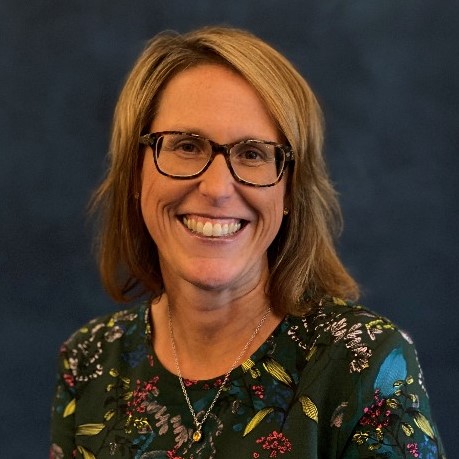
Jill Huynh
Vice President of New Business Development
Beech Acres Parenting Center
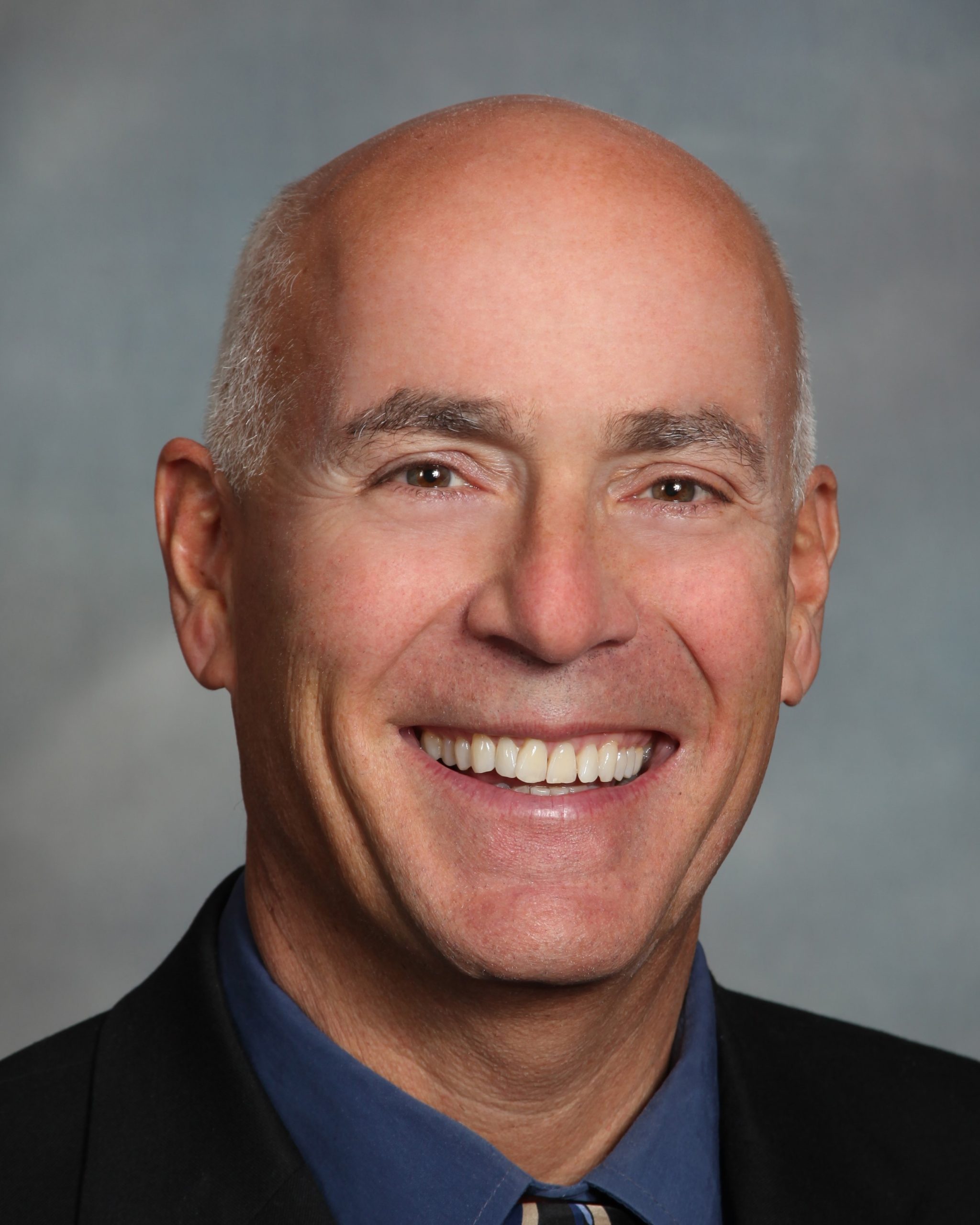
Eric Schindler
CEO
Child & Family Resources

David Siler
Executive Director of Indiana
National Youth Advocate Program Inc. (NYAP)
Moderator
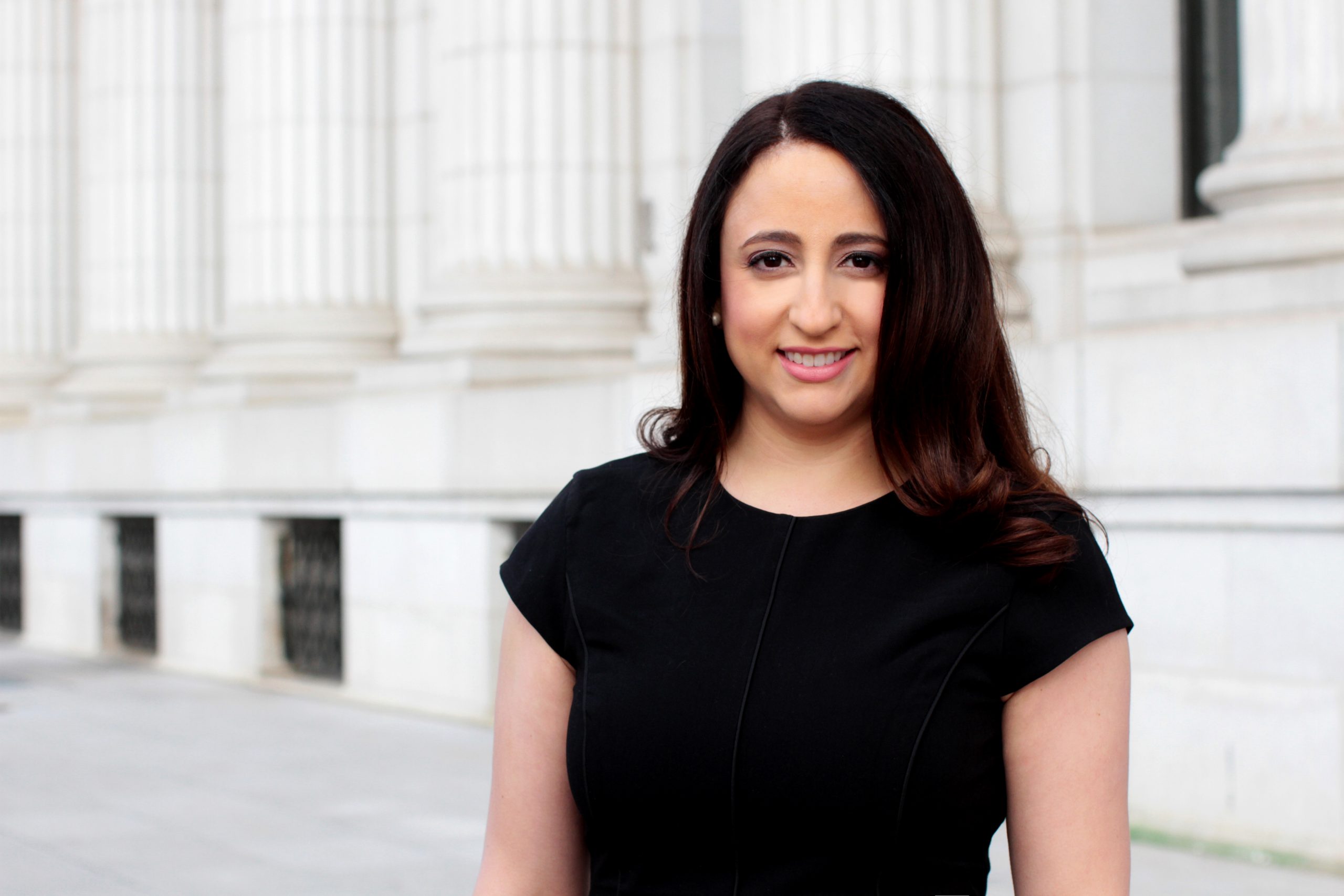
Ilana Levinson
Senior Director of Government Relation
Social Current
Related Events
The COVID-19 pandemic fundamentally changed the way we do advocacy as a sector. Gone are the days when nonprofits must organize dozens of flights to Washington, D.C., and navigate hectic lobby days. It’s also no longer necessary to wait weeks or even months for a legislator to return to the district to meet in person. Now, many of these activities can be done virtually with ease and professionalism. In fact, many legislators now prefer virtual meetings because they can talk with more constituents.
Social Current has conducted dozens of virtual meetings with legislators throughout the pandemic. This year, for example, our education advocacy team, made up of network organizations from across the nation, held more than 25 virtual meetings with members of Congress during our policy advocacy week in March. We also hosted meetings with key staffers on the education and appropriations committees in both chambers. Ultimately, this virtual campaign allowed us to build relationships with key decision makers on Capitol Hill and identify members of Congress who support our policy proposals.
As you consider how virtual events can help you achieve your advocacy goals, check out our tips for success below.
For more information, visit our Policy Action Center to download our newly updated toolkits: Social Current Public Policy Toolkit and Social Current Public Policy Toolkit: Media Relations, Events, and Social Media.
Virtual Advocacy Events
Virtual meetings allow organizations and coalitions to harness their collective power by meeting with multiple legislators in one day or week via Zoom, GoToMeeting, or WebEx. Legislators themselves have become used to this medium of communication and connection, and many organizations are taking advantage of it. Follow these steps to plan a successful virtual event.
Planning: 6-8 weeks in advance of the Virtual Advocacy Day:
- Nail down the date(s) of your advocacy day
- Create a centralized, accessible spreadsheet of information
- Decide on your main asks
Scheduling: 4+ weeks in advance:
- Draft scheduling request email with the advocacy day and the key issues you’d like to discuss
- Send invitations well ahead of time
- Identify key stakeholders from your network to participate in the meeting
Preparing: 1 week in advance:
- Schedule a prep session a week before your Advocacy Day to educate meeting participants on best practices for lobbying and advocacy (see the “Making Your Case” Chapter in our toolkit)
- Conduct a dress rehearsal and tech check to test video and screenshare technology and ensure all participants are comfortable with their talking points and other advocacy materials are ready
- Remind legislators and their staff about the scheduled meetings; send briefing packets for them to review beforehand
Executing: During the Meeting
- Meet with the invited legislators (See “Meeting with Your Legislator” and “Meeting with Staff” sections in our toolkit).
- Make sure to talk into the camera, not the screen; turn off notifications; dress professionally; and don’t multitask
- Send thank you email to legislators, answering any remaining questions that may have been raised during the meeting
New Resources for Building Your Advocacy Muscle
Social Current offers two newly updated advocacy toolkits, one with general public policy and advocacy how-tos and another with tips for media relations and social media to support advocacy. Inside, you’ll find sections on creating impact stories, engaging with legislators, developing media relations, hosting special events, and conducting social media outreach. They also contain brand new sections on virtual advocacy, constituent engagement and coalition building.
In addition to downloading the toolkits, connect with us to stay up to date on activity in Washington, take action on key issues, and gain support with your efforts:
- Follow us on Twitter @SoCurrentNews
- Visit our Policy Action Center for the latest action alert
- Reach out to our public policy team for one-on-one support
August marks National Immunization Awareness Month and is also the time of year many parents are buying school supplies, scheduling routine sports physicals, and ensuring their children have required vaccinations. Most of the country’s K-12 schools, after-school programs, and colleges are preparing to reopen and return to in-person instruction after more than a year of operating virtually due to the COVID-19 pandemic.
This year, parents of children over the age of 12 have a new task at hand—deciding whether to have their children receive the COVID-19 vaccine and then scheduling those appointments. Yet, many parents, educators, and health care providers continue to have questions about COVID-19 vaccine guidelines for children ages 12 and older.
In this on-demand webinar hosted by Morehouse School of Medicine’s National COVID-19 Resiliency Network, hear leading pediatricians and researchers answer questions from the community, discuss the safety and effectiveness of the COVID-19 vaccine, and explain strategies underway to ensure equitable access to the COVID-19 vaccine.
The webinar speakers include:
- Dr. Marcella Nunez-Smith, senior advisor to the White House COVID-19 Response Team and chair of the Presidential COVID-19 Health Equity Taskforce
- Dr. Lilly Immergluck, professor of microbiology, biochemistry, and immunology at Morehouse School of Medicine
- Dr. Christa Marie Singleton, senior medical advisor at the Centers for Disease Control and Prevention
During the webinar, they discuss:
- The Biden administration’s strategies to ensure equitable access to COVID-19 Vaccines
- COVID-19 Vaccine Guidelines for Children 12 years and older
- Strategies educators and schools can engage in to help build vaccine confidence
Listen to this episode of the podcast More than Health Care: Nonprofits and Health Care Working Together featuring Dr. Dominic Mack of MSM. Learn more about NCRN and the power that partnerships have in the fight for health equity amid the pandemic.
Additional Resources
- COVID-19 Prevention Strategies Most Important for Safe In-Person Learning in K-12 schools
- What are COVID-19 variants and how can you stay safe as they spread? A doctor answers 5 questions
- To find a vaccine near you and other resources for you, your family, and community visit the NCRN website or call 1-877-904-5097
It’s hard to believe it has been one year since the World Health Organization officially declared COVID-19 a pandemic and our world, as we knew it, changed.
There have been many heroes of this pandemic–the health care workers who persevere through long hours, personal protective equipment shortages, and unimaginable tragedy; the teachers who transitioned to virtual learning and continue to inspire their students; and the many essential workers who went about their daily jobs delivering packages, serving meals, and fighting fires despite the pandemic raging around them.
There is also another category of unsung essential workers that deserve our recognition and our accolades–our nation’s social workers. March is designated as National Social Work Month and this year’s theme from the National Association of Social Workers is Social Workers Are Essential.
Social workers are social heroes. They play a vital role in our communities–ensuring food availability, securing adoptions and forever homes, providing medical and behavioral health services, and helping ensure that all individuals and families have the opportunity to feel happy, healthy, and a sense of belonging.
Social workers connect communities to vital resources and in many cases, sit in roles where they address ongoing systemic and policy needs. They have had to adapt throughout this pandemic to continue to provide these services both virtually and in-person. And, with the spread of the pandemic, the need for social workers has grown even greater.
Across our nation, social workers have met these challenges in unique, creative, and heart-warming ways. At times putting aside their own needs and those of their families, social workers have offered essential care to people in need, whether dropping off food donations to families on fixed incomes, securing laptops and tablets to allow communications between seniors and their families, or advocating for state and federal policy to ensure people were cared for during this most critical time.
The demand for social services has dramatically increased while initially resources available to provide their services plummeted. Thankfully, with passage of the Biden administration’s American Rescue Plan Act where social workers were active advocates, many of these challenges will be met. Midsize and larger social sector organizations who had been shut out of earlier relief funding will have access to critical support. The $350 billion in state and local funding will enable social sector organizations to continue critical partnerships with government to respond to the changing needs of communities. The child care sector, which has experienced tremendous disruption, enrollment drops, and extra costs, will see $40 billion in childcare stabilization funding. A new Child Tax Credit Expansion that economists predict will cut childhood poverty in half is included that will provide for the basic needs that enable all families to thrive.
These measures will have a tremendous impact on shoring up support for social workers who have done so much for our communities over the past year. These measures were also advanced by social workers, amidst all else required of them this past year.
This March, let’s all celebrate the essential work of social workers who support individuals and families and answer their needs, not just in times of crisis, but every day.
Bridging Micro and Macro Social Work
Families and communities are stronger when they have access to the vital building blocks of health and well-being. Social work as a discipline and a methodology has been essential to the development and delivery of those building blocks and is most effective when grounded in the intersectionality of research, practice, and policy at individual, community, and systems levels. This bridging of micro and macro is what actualizes whole-person, whole-community aspirations into genuine and measurable impact.
Learn more about these approaches in Families in Society, the Alliance and Council on Accreditation (COA) social work research journal. The articles featured below for this month’s observance demonstrate the essentialness of micro and macro social work. Alliance and COA network partners can access all 100+ years of journal content in the online library as part of their network benefits, while others can select access options on the journal website.
- Seeking Champions for Change: A Positive Deviance Approach for Social Work
Given growing interest in and need for social innovation, social workers will benefit from knowing about positive deviance (PD), an approach that capitalizes on community creativity and individuals’ strengths in solving intractable problems in local neighborhoods. - Revisiting the Relationship between Micro and Macro Social Work Practice
Within the context of the shared mission of social work, there is a need for common ground that identifies the different ways that the two forms of practice can inform each other. Of particular importance are the core competencies relevant to intersectional interventions, collaborations, and partnerships. - The Life Course Perspective for Social Work: Bridging the Micro and Macro Worlds for Social Workers
This empirical perspective looks at how biological, psychological, and socio-cultural factors act independently, cumulatively, and interactively to produce great diversity in life course journeys and shape people’s lives across family generations. This understanding can lead to more effective practice interventions and policy solutions. - Re-Envisioning Macro Social Work Practice
To counter a generational trend of disinvestment in macro social work practice, 21st century strategies can support the historic vision of the social work profession as equally responsive to the needs of at-risk and disenfranchised populations and the organizational, community, and policy roots of social injustice.
Too often great ideas are kept in-house without recognizing their potential to create change beyond the communities where they are born. COA’s Innovative Practices Award (IPA) identifies, documents, and celebrates examples of successful approaches to management and service delivery practices adopted by our accredited organizations.
In 2020, a committee made up of COA volunteers and staff selected 4 finalists to move forward with a full case study. Alternative Family Services (AFS) came out the winner. Read on to find out how the AFS Enhanced Visitation Model kept families in touch during the crisis of COVID-19.
Helping families stabilize, heal, and reunify is an essential part of the work at Alternative Family Services. In-person visitation between kids in foster care and their biological family members is an integral part of the therapeutic process. The frequency of visits between parents and their kids are one of the strongest predictors of the family reuniting. The COVID-19 pandemic exacerbated the challenges kids and families must overcome on their journey towards reunification.
As the magnitude of the COVID-19 pandemic became more apparent, AFS staff and clients were suddenly faced with the reality that in-person visitation between kids and their family may be halted, or at the very least severely restricted. The ever-changing state and county guidelines added uncertainty and stress to the situation. Since many of our AFS staff, biological families, and foster families are considered a “higher-risk” demographic to have serious consequences from COVID-19, there was palpable fear in conducting in-person visits. AFS staff knew it was critical for families to continue to stay connected, especially during such uncertain times. So, a taskforce was formed that included representation from key AFS stakeholders. The group was asked to create a safe and equitable plan that would allow in-person visitation to resume. After much input and deliberation, the Enhanced Visitation Model was approved.
Exploring the AFS Enhanced Visitation Model
Health Risk Assessment
It was important for AFS staff to evaluate and address client’s COVID-19 concerns and mitigate the risk of individual exposure to the virus. The taskforce sought input from its constituents, researched professional resources, and ultimately developed the “Wellness Questionnaire.” Staff can rapidly administer this assessment tool to determine COVID-19 risk factors each visitor had been exposed to within the 14 days prior to an in-person visit.
Visitation Service Plan
A “Visitation Service Plan” is a simple, flexible, and predominately check-box/circle-based tool that seamlessly incorporates the risk factors identified in the “Wellness Questionnaire,” assigning families to one of three visitation service levels according to COVID risk level:
- Community-based (Low Risk): local government, community mandated precautions only (masks, handwashing, appropriate hygiene precautions)
- Social Distance Enhanced (Moderate Risk): physical distanced “Enhanced Visitation Venues” required
- Virtual Visitation (High Risk): virtual visitation only
AFS staff wanted to provide therapeutic strategies in a fun, genuine, and safe environment regardless of their Visitation Service Plan. Once the assessment and planning tools were established, staff needed to create pandemic-safe stations for families to interact.
Enhanced Visitation Venues
When families have a positive, stress-free visit, they are more likely to retain and practice the therapeutic skills they learn. So, AFS staff developed a variety of indoor and outdoor “Visitation Venues” that are fun, affordable, replicable, and portable. The visitation venues meet COVID-19 safety protocols so parents and their children can safely interact. Here are some examples of our indoor and outdoor venues:
Indoor Visitation Venues
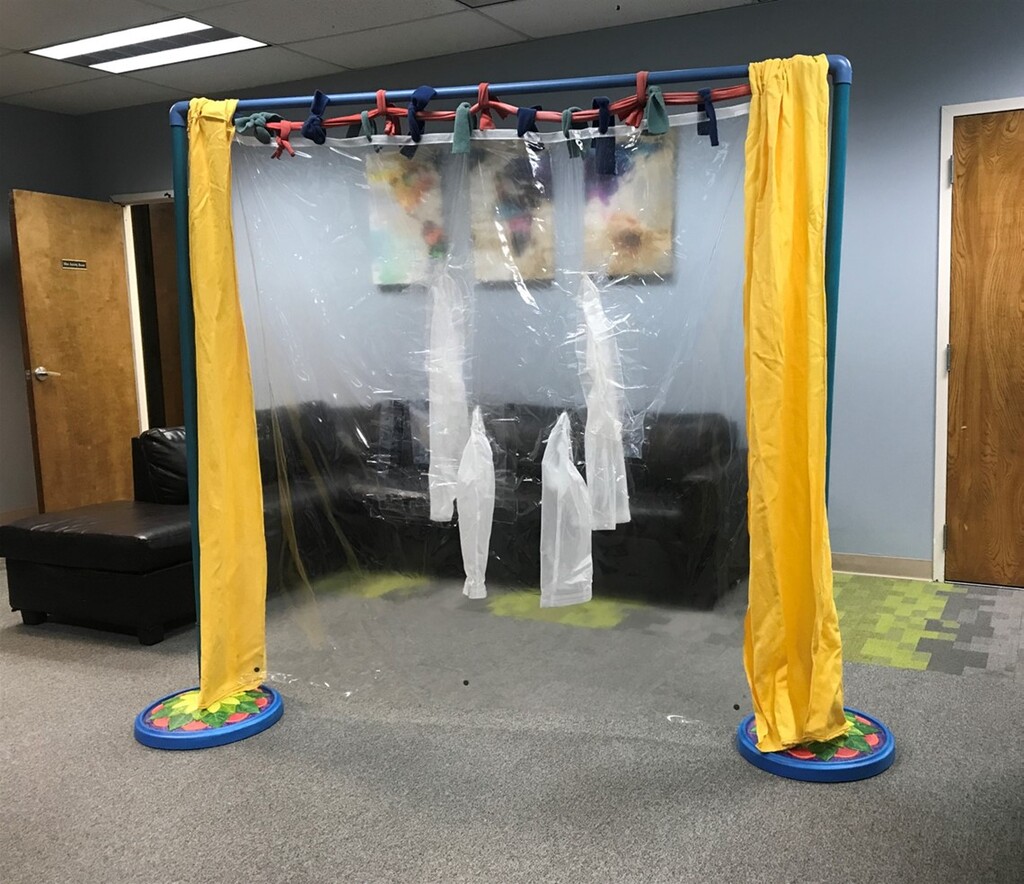
- The Hugging Station provides families with the opportunity to physically embrace, parents and children put on arm-length disposable gloves before reaching through sleeves attached to a transparent plastic curtain so they can safely hug during the pandemic. The Hugging Station can be easily decontaminated after each use.
- Activity Tables feature a Plexiglas divider, which sits on a table with parents on one side and child(ren) on the other. Participants can paint outlines of each other, play Tic-Tac-Toe or jointly create drawings with dry-erase markers, among other options.
- The Interactive Puppet Theater is where kids and parents make easy-to-construct sock puppets to safely “perform” in the puppet theater. It was designed with a table, clamps and Plexiglas with precut holes modified with rubber shields. AFS organized one-hour sock puppet workshops for staff so they can teach clients how to construct their own puppets for this playful encounter.
- Gaming Stations featuring video game consoles and large television screens allow families to play video games together while sitting at least six feet apart from one another, to ensure proper social distancing.
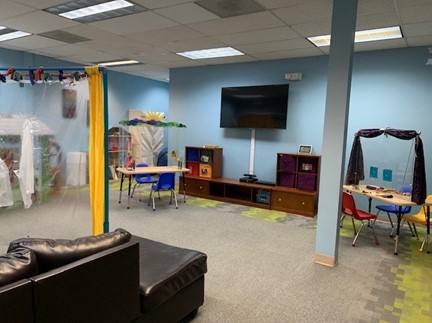
Curious to see what these options look like? Check out this video that highlights our indoor visitation venues.
Outdoor Visitation Venues
Since research has shown COVID-19 is less likely to spread between individuals while outdoors, AFS staff has developed a variety of safe outdoor venues that can easily be setup and disinfected after each use. When visits occur in the parking lots of one of our offices, artificial turf and gymnastic mats provide ground cover for families to play outdoor games. Pop-up tents provide shade when necessary, and bikes and tricycles are provided for families to ride together (staff uses a Clorox Total 360® Disinfectant Cleaner between uses).
AFS Visitation in 2021
The AFS Enhanced Visitation Model, funded with the assistance of the Walter S. Johnson Foundation, was the winner of COA’s 2020 Innovative Practices Award. While we were humbled to be selected, we are always striving to be innovative when it comes to providing the highest level of care to our children and families. At the end of every Enhanced Visitation Session, staff collects feedback from families to see what they like and what they feel has room for improvement.
While we are thankful that the COVID-19 vaccine is being distributed, AFS will continue to adhere to our Enhanced Visitation Model for the foreseeable future to ensure that staff, families and resource parents remain safe.
The views, information and opinions expressed herein are those of the author; they do not necessarily reflect those of the Council on Accreditation (COA). COA invites guest authors to contribute to the COA blog due to COA’s confidence in their knowledge on the subject matter and their expertise in their chosen field.
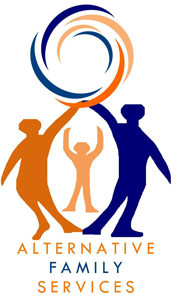
Alternative Family Services
Founded in 1978, Alternative Family Services (AFS) provides thoughtful, informed care, adoption and mental health services to foster children and youth throughout Northern California. The mission of Alternative Family Services is to support vulnerable children and families in need of stability, safety and wellbeing in their communities.
AFS, a COA-certified foster family agency, currently serves the diverse and varied needs of 1,500 foster youth, plus their biological and foster families, in the San Francisco Bay Area and Greater Sacramento Regions. Services provided by AFS include therapeutic foster care, Intensive Services Foster Care, support for foster children with developmental disabilities, therapeutic visitation, community-based mental health services, transitional housing support, independent life skills training, and much more.
In response to the COVID-19 pandemic, COA made adaptations to the Site Visit, a foundational part of the accreditation review. Incorporating feedback from our volunteers and organizations, the new virtual review options both allow organizations to move forward with completing their accreditation requirements and prioritize the safety and health of our Volunteers, organizations, and the individuals they serve, all while maintaining the integrity and rigor of our accreditation process. The virtual review is fundamentally designed to minimize in-person interaction amid the pandemic. Conducting interviews and reviewing onsite documents/evidence is completed remotely, through the use of HIPAA-compliant secure environment. When an in-person walkthrough of the organization is needed, assignment of local volunteers is prioritized to minimize travel (and any related concern(s)), and safety guidelines are stressed and followed.
As the pandemic continues to challenge all facets of our lives, we are tested to think differently, creatively, and with flexibility to accommodate for these unpredictable times. The move to virtual reviews required a quick turnaround from planning to implementation, and the continual feedback we have received has helped to refine the process. As a result, COA has increased different ways of communicating expectations and providing support, such as developing a checklist to clarify steps of the virtual review, establishing monthly meetings with leads of the review team, and hosting webinars on virtual reviews for organizations and Volunteers.
The collaboration between Volunteers and organizations has been instrumental in the successful implementation of the virtual review. We are pleased to relay reflections from a Volunteer for COA as she experienced her first virtual review!
COA – The virtual way
As I embarked on my July 2020 COA Zoom Site Visit journey as Team Leader, I questioned whether this was going to be the next future reality. I wondered if this was something I was comfortable doing and whether the integrity of the accreditation process was being compromised.
Also I thought…
What happened to the travel and enjoying new places? Good food? Spending time with colleagues? Meeting new people? Witnessing organizations taking care of those in their communities? Developing new programs? Learning and growing?
Retiring and giving back to the field was not supposed to be “virtual” – or was it?
We began with a team of four, and none of us had met or worked together (which make me think “great- now I have to juggle three new personalities as well as agency folks!”). We also covered a large portion of time zones, from Hawaii to mainland central time. “Oy vey!”
The team turned out to be one of the best I have ever worked with: a caring, dedicated group of professionals that were knowledgeable, patient, and flexible. We were not the most techie group, but thanks to the help of COA’s IT staff, we all figured it out.
I began with contacting the POC, using my social work skills to convince her that we knew what we were doing and everything would go smoothly. We started with a team Zoom meeting a few weeks before the review. We invited the agency POC to join the Zoom meeting so everyone could become acquainted, ask questions, and feel comfortable. It was decided that each Peer would set up their own schedule with the POC, with me only having to decide on the Entrance, Pre-Exit, Exit, and team meetings and my own schedule. Wow…it worked fantastic; everyone was happy! We decided to have a dedicated person assigned to each Peer that would be their “go-to” for all aspects of the review. (I secretly prayed that no one would drop off this review as I was beginning to feel some anxiety – I was worried it was going too well to be true!). We all began working at least week ahead of the actual date for the review, reviewing the Box, conducting interviews, going on virtual ASE facility tours, and working out IT bugs. We developed a back up plan with a conference number in case of any Zoom failure.
After numerous phone calls and emails, we had our team Zoom Sunday night to touch base before the Entrance Meeting. Everyone scheduled their Zooms with POC, and she did the invites from there. Easy!
Ready, set, g… no. One Peer couldn’t get Zoom fully working – maybe they would have it ready by the a.m.
Monday morning, all four Peer Reviewers were visible, and there were over 30 in attendance at the Entrance. We did the usual introductions, covered the COA process, and asked the agency CEO to give us some background and history of the organization. It was well done, and made up for some of the missed onsite interaction. The POC did an incredible job facilitating the whole process.
Zooms happened all day long without a glitch. Agency staff made sure the connections and introductions happened, and then dropped off the Zoom meeting.
Review of records and screen sharing went well, although we were not able to review as many records as we usually do. Meetings started and ended on time. Very few schedule changes were needed.
We added an additional Peer on the fly to agency to review the crisis center. No standards or ratings were assigned to her. She was just in and out and sent me a report – thank you! – which was wonderful.
Tuesday was the same. Very organized. Wednesday we Zoomed with team again before exit. We were all pretty Zoomed out and ready to be done. For the Exit Meeting, we had 76 in attendance on Zoom! Awesome!
The team did a wonderful job presenting on their standards, experiences, and sharing strengths with agency. By now it made no difference whether we were on-site or virtual. We were all connected, and the emotional impact that is often felt on site was present. The Peers presented with passion and professionalism. The CEO was grateful for the experience.
Although I, like most of my peers, am anxious to travel and be present with agencies, the COA staff have done an outstanding job figuring out how to get this done with integrity, best practices still in place, and camaraderie. Thanks!Oh, and the dietary question… the agency did send us all delicious cookies to enjoy at our home desks while working. A working snack – much appreciated. Thank you.
So my friends, “Zoom on” until it’s safe!
-Maddi Noleen, COA Peer Review Volunteer
Have questions about the virtual review process? Reach out to your Accreditation Coordinator, or contact us here.
COA would like to congratulate Alternative Family Services (AFS), a Resource Family Agency and mental health service provider serving Northern California, as winner of the 2020 Innovative Practices Award for its “Enhanced Visitation Model: Foster Care” program!
The Innovative Practices Award identifies, documents, and celebrates examples of successful approaches to management and service delivery practices adopted by our accredited organizations. Too often great ideas are kept in-house, without recognizing their potential to create change beyond. The purpose of the Innovative Practices Award is to amplify the effect of one great idea by elevating it to the national stage and offering it as a resource for direct service providers, leadership, researchers, and advocates across the full spectrum of human services.
This year, innovation is more important than ever. The COVID-19 pandemic has challenged every sector of our society, but it has presented special obstacles for the human and social services field. 2020 has also reinforced the urgent need for better equity, diversity, and inclusion. With that in mind, COA requested that Innovative Practices Award submissions address one or both topics.
This year’s evaluation process began with a preliminary round of submissions in which applicants provided a one-page synopsis of their innovative practice. Four finalists were selected to move forward and submitted their full case studies, which were reviewed by a team of expert judges. The community got to weigh in, as well, with hundreds of public votes making up 5% of each submission’s final score.
You can view the case study of the Enhanced Visitation Model program here.
ABOUT THE ENHANCED VISITATION MODEL PROGRAM
Visitation frequency between parent and child is one of the strongest predictors of successful family reunification within the foster care system. The initial response to the COVID pandemic for many agencies and institutions charged with overseeing family visitation was to restrict face to face services. Even as government and private agencies have begun to reinstitute face-to-face visitation, it is clear that the pandemic will ebb and flow. If visitation is going to be available to all families, some families will need to practice social distancing or utilize virtual technologies during visitation in order to contain contagion and meet foster parent fears and demands for safety. Families involved in the foster care system are often distrustful of how resources are allocated and rules are applied. When restrictions are placed upon parents’ right to visit their child, it is imperative that the process be transparent and equitable. To accomplish its purpose, the visitation experience must also be positive and encourage healthy interaction.
AFS’ Enhanced Visitation Model incorporates risk assessment and visit planning tools to assist staff in developing transparent and equitable visitation plans for all families. They have coupled this with replicable visitation activities or venues that can safely provide a continuum of healthy visit experiences regardless of risk level. Three levels of visitation service delivery address the special needs of families required to adhere to community, social distancing, or quarantine requirements. AFS’ Enhanced Visitation Model is designed to inspire clients and parents to play and communicate freely while minimizing the potential for client and family re-traumatization that can be caused by difficult to enforce rules and restrictive visitation environments. Their Enhanced Visitation Model is intentionally easy to replicate. They hope their model inspires and encourages family visitation providers to address the challenges of the COVID19 environment with innovative and creative visitation practices for all the families they serve.
Learn more about Alternative Family Services at afs4kids.org.
As we head into winter with the pandemic still raging, we wish our entire COA community health and safety. We know that many of our organizations provide essential services and have quickly implemented practices to reduce the spread of COVID-19. On behalf of the staff and board of COA, thank you for your continued service to your communities. We are inspired by your dedication and flexibility in this extremely difficult and ever-changing environment.
As organizations shift into and out of in-person work, the decision to move one way or the other is made even more challenging by conflicting guidance, mandates that vary across communities, and the unique challenges posed by virtual service delivery. Our hope is that this roundup of guidance from the field will help you make better informed decisions about how or if to return to conducting in-person work. We also hope that you’ll add your feedback and tips in the comments section to share your experiences and help our readers continue to adapt to this challenging time.
US Government Resources

Website of the Occupational Safety and Health Administration (OHSA)
From overview information to daily tips and updates, OHSA has an enormous amount of information about in-person work in the time of COVID-19. Find the latest guidance on hazard recognition, COVID-19 standards, medical information, and tips on control and prevention, as well as a number of other resources. Some materials are available in Spanish as well as English.

Website of OHSA’s Whistleblower Protection Program
This is the place to go to report unsafe working conditions, including unsafe conditions as they relate to COVID-19. You can also find information on the applicable law, COVID-19, how to create an anti-retaliation environment at your organization, and what to expect during a whistleblower investigation.

US Department of Labor COVID-19 Webpage
This site hosts a number of practical, nuts-and-bolts resources around workplace safety; wages, hours, and leave; unemployment insurance; and more, all as they relate to COVID-19. You will also find guidance on preventing the coronavirus at work, how to return to work during the pandemic, and how to keep the workplace safe until we can get a vaccine.
Workplace safety information is available in a number of languages, including Arabic, Brazilian Portuguese, Burmese, Chin, Chinese Simplified, Chinese Traditional, Croatian, French, French Creole, Hmong, Korean, Kunama, Nepali, Polish, Portuguese, Russian, Somali, Spanish, Swahili, Tagalog, Thai, and Vietnamese.

National Institute for Occupational Safety and Health Website
This site is especially useful as a resource for everything PPE, or Personal Protective Equipment. They have general tips on keeping staff safe, as well as information on the status of PPE supplies, what respirators are testing best, and crisis strategies on what to do if PPE runs low–a situation we saw at the beginning of the pandemic. There is also specific advice and strategies around navigating COVID-19 in schools, as well as how to reduce the risk of violence when having to confront clients who refuse to wear a mask or practice social distancing.

Center for Disease Control (CDC) Coronavirus Website
Of course, no government resource list would be complete without including all of the information available from the CDC. Here you will find helpful tips about wearing masks and which kinds of masks are most useful; the latest on COVID-19 symptoms and testing; the latest data and trends on cases; guidelines around quarantining and travel; and business-specific guidance and communication resources. Assistance in multiple languages is here as well.
Other resources

Returning to a Pre-Pandemic Workplace Resource Roundup from the Council on Nonprofits
The Council on Nonprofits walks through the factors an organization must weigh before returning to in-person work, and then provides their own list of resources for helping you with that decision. Some of our favorites include:
- Considerations for Community-Based Organizations from the Centers for Disease Control and Prevention, which offers specific advice for human and social service-type organizations looking to reduce community spread.
- Going Forward: Best Practices and Considerations for Nonprofit Re-engagement from the Oklahoma Center for Nonprofits, which guides organizations through guiding principles of engagement as they navigate the challenges of COVID-19.
- Reopening the Workplace: A Preliminary Guide for US Employers from Morgan Lewis LLP, which highlights key considerations around reopening or expanding operations and offers practical implementation steps.
- Take 10: Resume and Thrive Strategies from the Nonprofit Risk Management Center, which offers tips on cultivating the mental health and expectations of your workforce to foster a more successful future for everyone.
- Return to Work Resource Library from ThinkHR, which contains a number of videos, tip sheets, and more to help with all of the various challenges a team might encounter as a result of the pandemic.
Find their full list of resources here.

Reopening our Workspaces: A Playbook from Leading Edge
This playbook from the Leading Edge Alliance for Excellence in Jewish Leadership also takes on the considerations around returning to in-person work (or not) from a philosophical point of view. It walks through the many things an organization must weigh, including what impact their decisions will have on diversity, equity, and inclusion; team culture; organization values; and the opportunity that COVID-19 provides us all to “re-dream” what we could be doing.
The playbook contains decision trees to help leadership teams make careful, informed decisions about next steps in the face of the pandemic, as well as a wealth of practical tips and considerations on transitioning back to in-person work. The back half includes day-by-day checklists to help ease that transition.
Find the PDF of the playbook here.

HR Forms and Blog Posts from the Society for Human Resource Management (SHRM)
SHRM tackles the thorny HR issues that COVID-19 can surface and that staff may experience as they come into and out of the workplace. Their Coronavirus Resource page hosts back-to-work checklists, screening and notice forms, FAQs, COVID-19 culture quizzes, and more. Their blog posts offer troubleshooting advice on an array of issues such as social distancing, contact-tracing, and payroll. They also have articles that will help keep you up-to-date on what other companies’ HR departments are doing, providing inspiration and insight that might help your own organization.
Visit their Resource Page here. For more from SHRM, check out their helpful list of other reliable resources for workplace issues related to the coronavirus.

COVID-19 Return to Work Playbook from Kaiser Permanente
Kaiser Permanente’s all-in-one, clickable playbook offers tips on everything from the details of modifying workplace safety plans and COVID-19 screening to big-picture concerns such as the impact of the virus on the social drivers of health and emotional well-being. It even includes a section on specific guidelines for those who work in public services, which will be of special interest to the COA community.
What other resources have you seen or used that have been helpful? What re-opening tips and experiences would be helpful to other organizations like yours? Please share them in the comments below! Remember that you can always keep up-to-date on COA’s operational status during the pandemic on our COVID-19 Resources Page here


